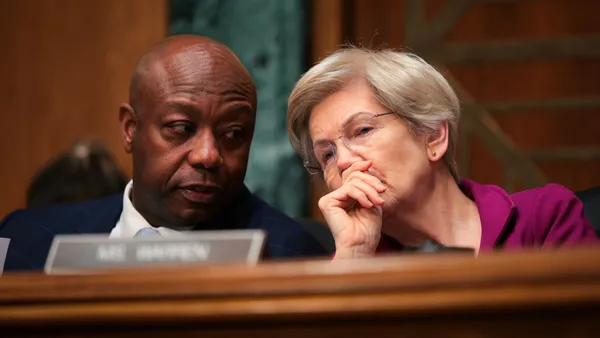Dive Brief:
- Colleges saw enrollment declines of 5% to 10% in the four years after being placed on probation by the Southern Association of Colleges and Schools Commission on Colleges, new research finds.
- The study, which spans 2006 to 2018, controls for a range of other factors to show the relationship between colleges receiving a negative accreditation action and students' deciding to enroll there.
- More research is needed to determine what factors contributed to the decreases and the extent to which students are aware of accreditation, the study's author said.
Dive Insight:
The study found that full-time-equivalent enrollment decreased 5.5% at public four-year colleges two years after being put on probation by the regional accreditor. At public two-year schools, FTE enrollment fell 9.4%. Private four-year nonprofits saw decreases sooner, with FTE enrollment falling 7.7% within two years of being given a warning, which is less severe than probation.
"I was expecting, if there was a relationship, for it to be somewhat smaller," said Christopher Burnett, a postdoctoral fellow in education leadership and policy studies at the University of Houston. The argument for the value of accreditation, along with perceptions that students hold regional accreditation in high esteem, motivated Burnett to take on the research.
Regional accreditation is considered the premier form of accreditation in the U.S. Those notions are being challenged, however, as the U.S. Department of Education last year removed the geographic distinctions among the nation's seven regional accreditors. Already, some accreditors have said they would consider working outside their historical limits, though critics of the department's move worry it will lower quality assurance standards.
Although Burnett's study found a relationship between enrollment and sanctions, more research is needed to understand their impact. For instance, Burnett noted, the generally higher cost of attending a private college may have prospective students more attuned to quality indicators such as accreditation.
A sanction on a community college, meanwhile, may be more apparent to people in the community via local media coverage than a sanction at a college across the state.
Schools might also be responding to the sanction in ways that could lower enrollment, such as by eliminating academic programs or raising their standards for admission, Burnett said. And a scandal could prompt a sanction and an enrollment decline.
Antoinette Flores, director of postsecondary education at the Center for American Progress, raised the question of whether certain situations that spur a sanction, such as financial or leadership troubles, made a difference in enrollment, because they could influence quality indicators for students.
Bias could also be a factor. In another study, Burnett found SACSCOC-accredited schools that were HBCUs were more likely to be sanctioned than non-HBCUs.
UNCF criticized SACSCOC in a 2019 white paper contending it put HBCUs on probation at a "considerably higher" rate than the other schools it accredits.
Burnett cautioned accreditors to consider how their processes could disadvantage certain types of institutions, including HBCUs. UNCF recommended changes to the accreditors' peer review process, including having an outside group review it.
Burnett and Flores advise colleges to be proactive to blunt the impact of a sanction, explaining what their issues are and how they are going to address them.
While accreditors are "very unlikely" to remove accreditation, in some cases such actions should be quality indicators for students, Flores said. "But if there's not clarity there for students to figure out what the problem is or whether it is a factor in deciding to enroll, that complicates things."














